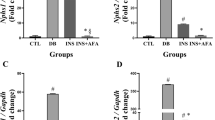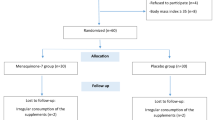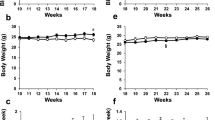Abstract
Background
Some animal and cellular experiments showed that ampelopsis grossedentata (APL) was helpful to improve insulin resistance or glucose uptake.
Objective
The aim of this study was to assess the effects of APL on blood glucose metabolism, lipid, and renal function parameters in adults with type 2 diabetes mellitus (T2DM).
Methods
Eighty participants with T2DM were randomly assigned to the APL group (n = 40, 10 g of APL daily contained 970 mg of dihydromyricetin) or to the placebo group (n = 40, 10 g of APL daily deleted dihydromyricetin) for 1 month in a double-blind, randomized clinical trial. Blood levels of glucose and insulin, lipids, and renal function parameters were assayed.
Results
Seventy subjects completed the trial (36 in the APL group and 34 in the placebo group). The baseline characteristics were similar between the two groups. Compared with the placebo group, the levels of fasting plasma glucose, glycated albumin, cystatin C, and retinol binding protein-4 significantly decreased (all p < 0.05). Meanwhile, the levels of other lipids, apolipoproteins, and other parameters did not change.
Conclusions
One-month supplementation with APL obviously improved the glycemic control and parameters of renal function in adults with T2DM. Our findings suggested that a potential role for APL in the prevention and treatment of T2DM.
This is a preview of subscription content, access via your institution
Access options
Subscribe to this journal
Receive 12 print issues and online access
$259.00 per year
only $21.58 per issue
Buy this article
- Purchase on Springer Link
- Instant access to full article PDF
Prices may be subject to local taxes which are calculated during checkout

Similar content being viewed by others
References
Xu Y, Wang L, He J, Bi Y, Li M, Wang T, et al. Prevalence and control of diabetes in Chinese adults. JAMA. 2013;310:948–59.
Salas A, Acosta D, Ferri CP, Guerra M, Huang Y, Jacob KS. et al. The prevalence, correlates, detection and control of diabetes among older people in low and middle income countries. A 10/66 Dementia Research Group Population-Based Survey. PLoS ONE. 2016;11:e0149616
Holden SE, Jenkins-Jones S, Morgan CL, Peters JR, Schernthaner G, Currie CJ. Prevalence, glucose control and relative survival of people with Type 2 diabetes in the UK from 1991 to 2013. Diabet Med. 2017;34:770–80.
Huang ES, Liu JY, Moffet HH, John PM, Karter AJ. Glycemic control, complications, and death in older diabetic patients: the diabetes and aging study. Diabetes Care. 2011;34:1329–36.
Chung JO, Cho DH, Chung DJ, Chung MY. Serum cystatin C levels are positively associated with cardiovascular autonomic neuropathy in patients with type 2 diabetes. Exp Clin Endocrinol Diabetes. 2015;123:627–31.
Zheng CM, Ma WY, Wu CC, Lu KC. Glycated albumin in diabetic patients with chronic kidney disease. Clin Chim Acta. 2012;413:1555–61.
Chen CW, Drechsler C, Suntharalingam P, Karumanchi SA, Wanner C, Berg AH. High glycated albumin and mortality in persons with diabetes mellitus on hemodialysis. Clin Chem. 2017;63:477–85.
Ajala O, English P, Pinkney J. Systematic review and meta-analysis of different dietary approaches to the management of type 2 diabetes. Am J Clin Nutr. 2013;97:505–16.
Schwingshackl L, Chaimani A, Hoffmann G, Schwedhelm C, Boeing H. A network meta-analysis on the comparative efficacy of different dietary approaches on glycaemic control in patients with type 2 diabetes mellitus. Eur J Epidemiol. 2018;33:157–70.
Liu K, Zhou R, Wang B, Chen K, Shi LY, Zhu JD, et al. Effect of green tea on glucose control and insulin sensitivity: a meta-analysis of 17 randomized controlled trials. Am J Clin Nutr. 2013;98:340–8.
Zhou Y, Liang X, Chang H, Shu F, Wu Y, Zhang T, et al. Ampelopsin-induced autophagy protects breast cancer cells from apoptosis through Akt-mTOR pathway via endoplasmic reticulum stress. Cancer Sci. 2014;105:1279–87.
Zhou Y, Shu F, Liang X, Chang H, Shi L, Peng X. et al. Ampelopsin induces cell growth inhibition and apoptosis in breast cancer cells through ROS generation and endoplasmic reticulum stress pathway. PLoS ONE. 2014;9:e89021
Rahman NA, Yazan LS, Wibowo A, Ahmat N, Foo JB, Tor YS, et al. Induction of apoptosis and G2/M arrest by ampelopsin E from Dryobalanops towards triple negative breast cancer cells, MDA-MB-231. BMC Complement Altern Med. 2016;16:354.
Park GB, Jeong JY, Kim D. Ampelopsin-induced reactive oxygen species enhance the apoptosis of colon cancer cells by activating endoplasmic reticulum stress-mediated AMPK/MAPK/XAF1 signaling. Oncol Lett. 2017;14:7947–56.
Weng L, Zhang H, Li X, Zhan H, Chen F, Han L, et al. Ampelopsin attenuates lipopolysaccharide-induced inflammatory response through the inhibition of the NF-kappaB and JAK2/STAT3 signaling pathways in microglia. Int Immunopharmacol. 2017;44:1–8.
Zhou Y, Wu Y, Qin Y, Liu L, Wan J, Zou L. et al. Ampelopsin improves insulin resistance by activating PPARgamma and subsequently up-regulating FGF21-AMPK signaling pathway. PLoS ONE. 2016;11:e0159191
Liu L, Zhou M, Lang H, Zhou Y, Mi M. Dihydromyricetin enhances glucose uptake by inhibition of MEK/ERK pathway and consequent down-regulation of phosphorylation of PPARgamma in 3T3-L1 cells. J Cell Mol Med. 2018;22:1247–56.
Le L, Jiang B, Wan W, Zhai W, Xu L, Hu K, et al. Metabolomics reveals the protective of Dihydromyricetin on glucose homeostasis by enhancing insulin sensitivity. Sci Rep. 2016;6:36184.
Liu L, Wan J, Lang H, Si M, Zhu J, Zhou Y, et al. Dihydromyricetin delays the onset of hyperglycemia and ameliorates insulin resistance without excessive weight gain in Zucker diabetic fatty rats. Mol Cell Endocrinol. 2017;439:105–15.
Chen S, Zhao X, Wan J, Ran L, Qin Y, Wang X, et al. Dihydromyricetin improves glucose and lipid metabolism and exerts anti-inflammatory effects in nonalcoholic fatty liver disease: a randomized controlled trial. Pharmacol Res. 2015;99:74–81.
Soltani R, Gorji A, Asgary S, Sarrafzadegan N, Siavash M. Evaluation of the effects of cornus mas L. fruit extract on glycemic control and insulin level in type 2 diabetic adult patients: a randomized double-blind placebo-controlled clinical trial. Evid-Based Complement Altern Med. 2015;2015:740954.
Bhatt JK, Thomas S, Nanjan MJ. Resveratrol supplementation improves glycemic control in type 2 diabetes mellitus. Nutr Res. 2012;32:537–41.
Kim IY, Kim MJ, Lee DW, Lee SB, Rhee H, Song SH. et al. Glycated albumin is a more accurate glycemic indicator than hemoglobin A1c in diabetic patients with pre-dialysis chronic kidney disease. Nephrology. 2015;20:715–20.
Lu JM, Ji LN, Li YF, Li QM, Lin SS, Lv XF, et al. Glycated albumin is superior to glycated hemoglobin for glycemic control assessment at an early stage of diabetes treatment: a multicenter, prospective study. J Diabetes Complicat. 2016;30:1609–13.
Hoogeveen EK, Geleijnse JM, Kromhout D, Stijnen T, Gemen EF, Kusters R, et al. Effect of omega-3 fatty acids on kidney function after myocardial infarction: the Alpha Omega Trial. Clin J Am Soc Nephrol. 2014;9:1676–83.
Juraschek SP, Chang AR, Appel LJ, Anderson CA, Crews DC, Thomas L, et al. Effect of glycemic index and carbohydrate intake on kidney function in healthy adults. BMC Nephrol. 2016;17:70.
Vallianou NG, Georgousopoulou E, Evangelopoulos AA, Bountziouka V, Bonou MS, Vogiatzakis ED, et al. Inverse Relationship between Adherence to the Mediterranean Diet and Serum Cystatin C Levels. Central Eur J Public Health. 2017;25:240–4.
Yang SK, Liu J, Zhang XM, Hu C, Zhang W, Sun L, et al. Diagnostic accuracy of serum cystatin C for the evaluation of renal dysfunction in diabetic patients: a meta-analysis. Ther Apher Dial. 2016;20:579–87.
Zhou B, Zou H, Xu G. Clinical utility of serum cystatin C in predicting diabetic nephropathy among patients with diabetes mellitus: a meta-analysis. Kidney Blood Press Res. 2016;41:919–28.
Ram J, Snehalatha C, Selvam S, Nanditha A, Shetty AS, Godsland IF, et al. Retinol binding protein-4 predicts incident diabetes in Asian Indian men with prediabetes. Biofactors. 2015;41:160–5.
Sun L, Qi Q, Zong G, Ye X, Li H, Liu X, et al. Elevated plasma retinol-binding protein 4 is associated with increased risk of type 2 diabetes in middle-aged and elderly Chinese adults. J Nutr. 2014;144:722–8.
Bose KS, Gupta SK, Singh S. Is serum retinol binding protein-4: a predictor for diabetes in genetically high risk population? J Res Med Sci. 2012;17:1015–9.
Graham TE, Yang Q, Bluher M, Hammarstedt A, Ciaraldi TP, Henry RR, et al. Retinol-binding protein 4 and insulin resistance in lean, obese, and diabetic subjects. N Engl J Med. 2006;354:2552–63.
Feng S, Zhu Y, Yan C, Wang Y, Zhang Z. Retinol binding protein 4 correlates with and is an early predictor of carotid atherosclerosis in type 2 diabetes mellitus patients. J Biomed Res. 2015;29:451–5.
Shi L, Zhang T, Liang X, Hu Q, Huang J, Zhou Y, et al. Dihydromyricetin improves skeletal muscle insulin resistance by inducing autophagy via the AMPK signaling pathway. Mol Cell Endocrinol. 2015;409:92–102.
Author Contributions
LR, YQ designed the research; LR, XLW, HDL, JX, JW, HL, MTM, and YQ conducted the research; LR, HDL, and JX analyzed the data; LR, XLW, and YQ performed statistical analysis and wrote the manuscript; YQ and MTM had primary responsibility for final content. All authors read and approved the final manuscript.
Author information
Authors and Affiliations
Corresponding author
Ethics declarations
Conflict of interest
The authors declare that they have no conflict of interest.
Rights and permissions
About this article
Cite this article
Ran, L., Wang, X., Lang, H. et al. Ampelopsis grossedentata supplementation effectively ameliorates the glycemic control in patients with type 2 diabetes mellitus. Eur J Clin Nutr 73, 776–782 (2019). https://doi.org/10.1038/s41430-018-0282-z
Received:
Revised:
Accepted:
Published:
Issue Date:
DOI: https://doi.org/10.1038/s41430-018-0282-z



